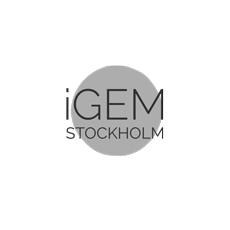Human Practices - TECH
Sharing information and igniting interest in synthetic biology
Even though the field of synthetic biology may seem difficult to define and beyond the remit of many people’s day to day lives, its presence in our homes and workplaces is ever growing.
Many of the foods we buy, medicines we use and services that are offered would not exist without synthetic biology and are very much taken for granted. This means that without knowledge of a product's origin, production process, proper usage and disposal, some risks are inevitable. For these reasons, we believe it is vital to make information accessible to people in all walks of life, allowing them to make informed decisions.
We have tried to demonstrate a model for achieving this through integrating education, increased public awareness and of course, igniting curiosity in synthetic biology.
 iGEM Stockholm’s human practices project extends far beyond the bench through our novel integrated TECH (iTECH) model, bringing together the four different components of our Human Practices work: Teaching, Evolving, Community & Health.
iGEM Stockholm’s human practices project extends far beyond the bench through our novel integrated TECH (iTECH) model, bringing together the four different components of our Human Practices work: Teaching, Evolving, Community & Health.
TEACHING: Schools Projects
EVOLVING: Makerspace Lab & Workshops
COMMUNITY: Integrating Human Practices & Nordic iGEM Conference
HEALTH: Expert advice and the development of SMITe
The iTECH model framework has allowed us to develop a public dialogue, which engages with different groups of the population about synthetic biology and the journey from the lab towards our product. Overall this vastly improved the foundations of our research and challenged us to question how and why our project could be successful.
The following are different ways our Human Practices project has impacted our society:
- Raising awareness of synthetic biology at all educational levels (spanning ages 9-11, 15-18 and 20+ in different arms of the project)
- Providing an educational backdrop for young researchers on a practical and theoretical basis
- Encouraging creative thinking in the approach to combating deep seated problems
- Introducing innovative new approaches to treating chronic wounds
- Promoting consideration of the global impact of human civilisation and how we can use synthetic biology in the future to adapt to a changing world
- Predicting the consequences of inaction in relation to antimicrobial resistance on future generations
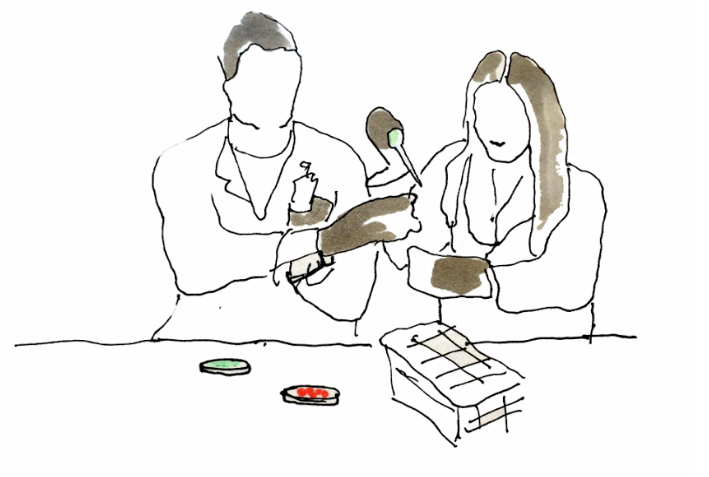
Teaching
Giving students an insight to the controversial questions within synthetic biology and its many perks as well as creating a platform to connect all sorts of students in an international setting
In May 2016 we first reached out to a group of high school students ranging between the ages of 15 and 18, who had all undertaken biology as part of their A level education. The concept of iGEM had already been introduced into their curriculum through an extended exam question based on a scientific article discussing synthetic biology, iGEM and the use of standard biological parts, so we took the opportunity to expand on these principles and help students apply them to a host of real life situations.
The overall aim was to inspire students with an innate interest in biology (just like us) to pursue these new ideas in more depth and possibly be influenced into studying these even further as they progress through their education. Naturally we also aimed to make the project interesting, thought provoking, collaborative and fun!
Following a positive response from both teachers and pupils about becoming involved in our project, we developed an online educational programme composed of case studies, which was accessible through our main website.
Details regarding the construction of this programme and interaction with the students can be found on our Public Engagement and Education page.
Evolving
Evolving - Stockholm Makerspace
To be a part of a bigger movement amongst the Biohacker community
Our initial interaction with Biohackers was during the first Bio-Makers conference in Sweden; an event hosted by and for bio-makers, bio-hackers and DIY-biologists with the aim to share inspirational stories and practical hacks and protocols from the international biohacker movement. These were the themes of the conference: Lab, health, cyborg and community, which coincided with our project, providing a great occasion with an enthusiastic crowd for presenting our work. We seized this opportunity and enrolled the team to participate, by submitting an abstract of our project plan for the iGEM Competition. We were granted a space for our poster workshop presentation in their conference, to convey our ideas and discuss the critical health issue we proposed to tackle.
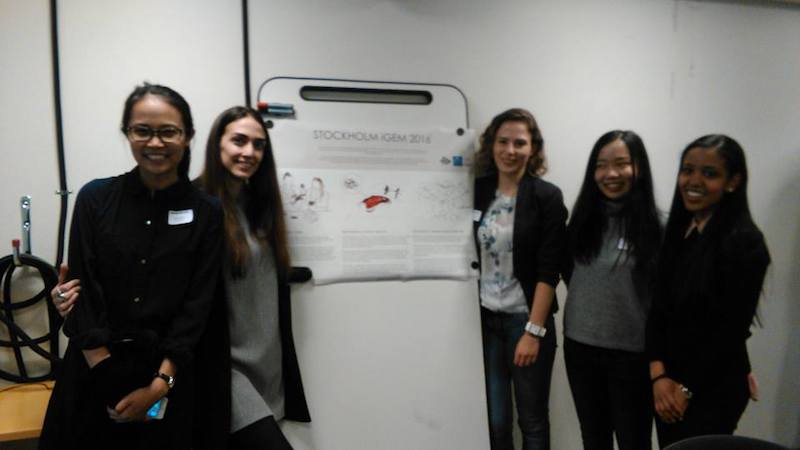
What is a Makerspace?
A Makerspace (also called hackspace / fab lab) is a location where people with common interests, often in computers, technology, science, digital or electronic art (but also in many other realms) can meet, socialise and/or collaborate.
Several participants were interested in our innovation. Amongst them was the founder of BioNyfiken and board member of Stockholm Makerspace, who was eager to contribute to our project. BioNyfiken is a biohackers network hosting workshops and meetups involving speaking events and training in biohacking, synthetic biology, quantified self and related topics. Their goal is to spread the knowledge of what is possible to do with biotechnology as technology becomes more accessible to the public, and encourage people without any training in those subjects to use technology to examine themselves and their environment and drive the biotechnological development. With over 500 members and a newly licensed DIY biosafety level I openlab space approved by Arbetsmiljöverket (equivalent to the Occupational Safety and Health Administration), we have organized interactive workshops consisting of theoretical presentations followed by laboratory practicals in bacteria sampling, plating, identification, as well as basic techniques such as pipetting and microscopy. This allows for the society to get a hands-on experience in synthetic biology and at the same time be involved in our work.
Open House at Stockholm Makerspace
On 20th of August, the biolab at Stockholm Makerspace had an open house co-hosted by iGEM Stockholm 2016. Everyone was invited and around 50 people of all ages with a wide variety of backgrounds other than synthetic biology participated. Attendees had the opportunity not only to learn more about synthetic biology and how a basic laboratory is structured and operates but also to try out basic but essential skills using a range of equipment and experimental procedures. Following a presentation detailing Stockholm Makerspace, iGEM Stockholm 2016 and the overall collaboration, everyone was curious and mingled through different stations we set up around the lab, including: DNA extraction from kiwis and cherries, introduction to pipetting, gel electrophoresis and PCR.
At this event we were fortunate to be able to announce the three upcoming workshops hosted by iGEM Stockholm at the Makerspace lab: “Lab Basics”, “Cultivation” and “Glowing E. coli”.
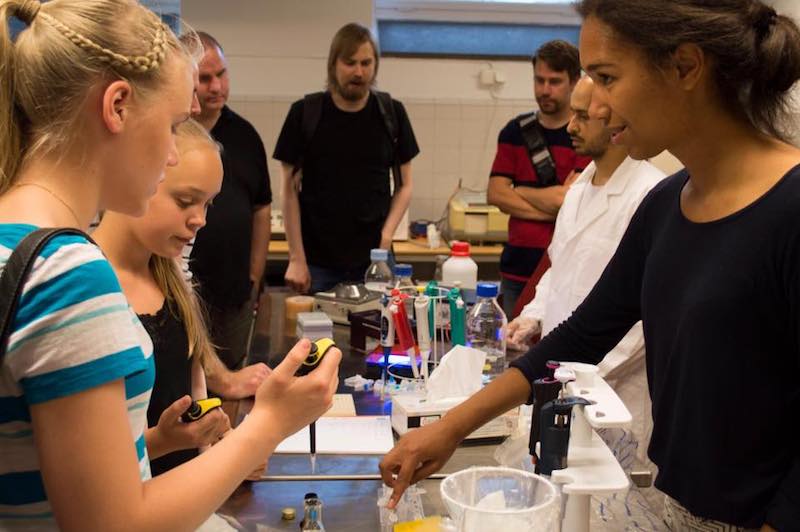
See what we managed to achieve with these 'Bio Curious' individuals who actively seek to donate their free time to expanding their knowledge in futuristic biology through Makerspace.
Information about the workshops, which ran over three weeks in September 2016, can be found on our Public Engagement and Education page.
Community
At the start of the summer we hosted Nordic iGEM Conference (NiC); a weekend long event held by one of the Nordic iGEM teams in their home country each year. In the spirit of the iGEM Competition NiC is held to connect and share ideas and knowledge with synthetic biology in focus.
This weekend was packed with novel ways to learn and collaborate and we decided to extrapolate the themes of the conference into our Human Practices projects.
Workshops
Everyone attending the NiC conference had the opportunity to participate in two workshops consisting of interactive presentations, case studies and discussions.
How does this fit into our community?
We found the workshop structure to be a great way to engage individuals of multiple different interests in a broad range of subjects and were really inspired to use this scaffold in other ways.
Since the Biomakers community were so keen to develop skills and to be able to have an up and running lab, we thought this was a great way to gradually introduce concepts, skills and discussions. The result was the Evolving arm of our iTECH model.
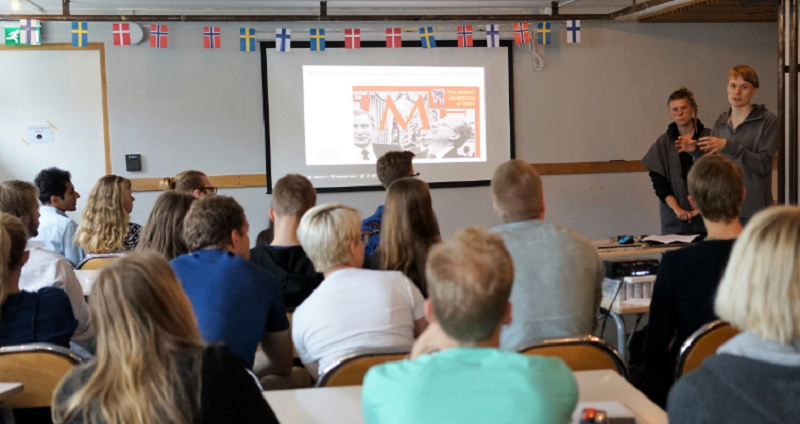
Speculative design
During NiC, Linnea Våglund and Leo Fidjeland from this year's iGEM Stockholm team presented the concept of design within synthetic biology. Attendees had time to get creative with brainstorming activities to exchange ideas within this field.
How does this fit into our community?
Inspiring an interest in the possibilities afforded by biology for the scientists of our future
The bridge between design and biology is ever diminishing and this was a really well- received concept within NiC. We reflected that innovation and creativity are important skills to nurture and invest in so we decided to try and spark interest at a basic level in the concepts we had all seen from a new angle thanks to Linnea and Leo!
There is no better better place to look for 'out-of-the-box' creativity than young children, so as a result, we developed the basis for our primary school education programme. Here the focus was on getting students to think of and design futuristic products which could be made out of spider silk and, considering the material properties of the spider silk, why was it particularly suited to their model.
See our Public Engagement and Education page for some brilliantly insightful and creative ideas from the scientists of our future, which resulted from our teaching resources.
Unsolved ethics
An introduction on ethics in synthetic biology was presented by Marko Ahteensuu, followed by group discussions. In this workshop there was the opportunity to learn about ethical issues that may arise from synthetic biology, acknowledge principles underlying these issues and how they are currently handled in society. They also identified possible ethical issues that may emerge from individual projects, as well as approaches that can be considered to minimize unwanted outcomes.
How does this fit into our community?
As such great discussion was generated from these ethics discussions, we chose to try and integrate the issues which were highlighted as most important into the teaching arm of our iTECH model. The resulting focus for the student case studies was based on the question of 'just because we can, should we?'.
We wrote case studies in three main subject areas: health, environment and design, and for each one decided to include an element of ethical discussion. For health we asked students about the consequences of unsupervised production and use of hormones, for environment we asked students to consider the impact of new biological solutions to natural conservation problems and how this might disrupt our natural world. Finally, for design, we incorporated questions of both the impact of biological architecture on local ecosystems and also how could bacterial based solutions to every day problems be made acceptable in our society. The results were intriguing! See the Integrated HP page for details.
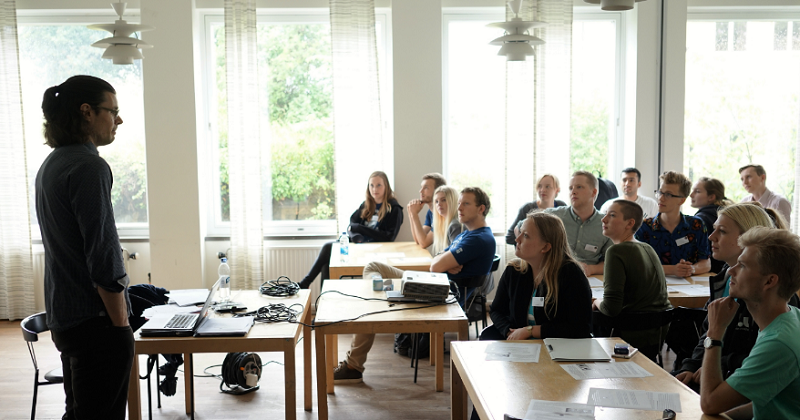
Mini-Jamboree
The Mini-Jamboree was an event in which all Nordic Teams presented their synthetic biology projects during the conference. The criteria for the project presentations was based on the official iGEM criteria and a panel of judges presented this year's winners during the Gasque dinner party. The winning team has the honour of hosting the next annual NiC!
How does this fit into our community?
NiC is a fantastic opportunity for networking, discussing ideas and giving feedback on each other's work. We felt involvement in the organisation and planning of this weekend was a great dress rehearsal for the Boston Jamboree and all the Nordic iGEM teams benefited from the opportunity to receive constructive criticism from peers and also be inspired by different approaches to the competition!
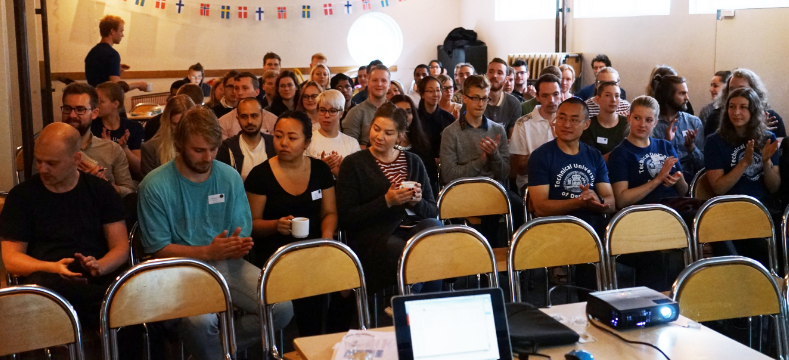
Health
Interview with Professor Rotimi: Clinical Microbiologist
Generating a deeper understanding of critical world health issues related to SMITe
Professor Vincent O Rotimi, MD, PhD, FRCPath, is a university professor of clinical microbiology at the Faculty of Medicine, Kuwait University. He is also a longstanding consultant and Head of the Clinical Microbiology Unit at Kuwait’s largest laboratory in Mubarak Kabeer hospital, and an active researcher who has published numerous papers on microbiology, antibiotic resistance, anaerobic bacteriology, hospital infections and various diseases.
The purpose of the interview was to discuss critical topics regarding antibiotic resistance in Kuwait, how these risks have been realized in hospitalized patients treated, for example, in the intensive care unit, and to discuss the microbiology of chronic diabetic wounds. The interview concluded with a discussion about how our product SMITe could find its place as a potential therapeutic solution to excessive antibiotic prescriptions for chronic wounds and the adaptations is might require.
Following the interview we reflected on the topics covered and formulated a list of questions we now needed to address in order to make our concept acceptable and useful. This is viewable in our Integrated Human Practices page.
Many thanks to Professor Rotimi for his participation. (Pictured with iGEM team member Betty, below).
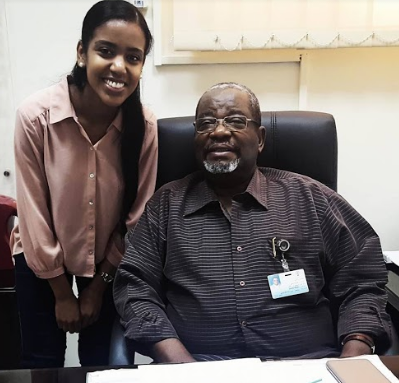
Question: I would like to start by asking a few questions regarding antibiotic and multidrug resistance (MDR) in the local area. This is to give us a brief understanding of antibiotics and the increasing risks of MDR caused by the overuse and misuse of antibiotics.
Answer: Good morning Bethel. First of all let me define what an antibiotic is. Antibiotics are naturally occurring or semi-synthetic chemical substances that inhibit the growth of bacteria and are used extensively in medicine for the treatment of bacterial infections. However, they are not a panacea for every bacterial infection. They are beneficial and in many cases life-saving. Despite these desirable effects, they can unfortunately produce dangerous toxic side-effects. The risk of developing resistance is another serious downside of these wonderful chemical compounds. Methods by which bacteria become resistant to antimicrobial agents include 1) an alteration in permeability of bacterial cell wall to the antibiotic, 2) an alteration in the target binding sites on the bacteria, 3) use of an alternative metabolic pathway, 4) mutation on a gene coding for antibiotic-destroying enzyme and 5) acquiring a new gene for an antibiotic-destroying enzyme. The genes that mediate antibiotic resistance can be transmitted between organisms of the same species (intra-transfer) and species of different genera (inter-transfer). As a result resistance to commonly used antibiotics can become widespread in previously susceptibility organisms. These genes (DNA) are transmitted by 4 mechanisms: transformation, transduction, conjugation and transposons. Some gram-negative bacteria may acquire multiple resistance determinants gathered together on one of these transmissible elements thereby making the organisms difficult to treat and eradicate from hospital environment. Klebsiella pneumoniae and Acinetobacter baumannii containing these types of elements are good example of multi-drug resistant (MDR) pathogens circulating in many hospitals, including our hospital here in Kuwait.
Question: How could the risk of future (infectious) outbreaks be reduced? Could we prevent this from happening?
Answer: Overuse and misuse of antibiotics help to exert selective pressure for these MDR bacteria. To eradicate the existing MDR organisms from the hospital environment all possible selective pressures must be avoided by judicious prescription and use of antibiotics and excluding the antibiotics to which the bacteria are resistant from susceptibility reports. The Hospital Infection Control (ICC) Unit of any hospital has an important role to play in the prevention of outbreaks. For successful prevention and control the infection control doctor/nurses must be very active and liaise regularly with the microbiology laboratory so as to be able to identify any potential outbreak early before it festers. We have an ICC in the hospital that meets every month or every 2 months and an infection control team (ICT) charged with the tasks of carrying out the day-to-day duties of the ICC. Education of healthcare providers on antibiotic stewardship, resistance surveillance and periodic publication of local antibiogram by the microbiology laboratory are also important.
Question: Are there any other therapeutic options except new or higher potency antibiotics to help in the battle against MDR organisms?
Answer: We have limited options for the treatment of infections caused by MDR bacteria. Unfortunately, the prospects of developing new anti-infective agents is very dim. The pipe-line is dry, as they say. The cost of production of antibiotics is extremely high and very few pharmaceutical companies are willing to take on the task. We are left with previously abandoned drugs like colistin, because of it's toxicity, to treat many MDR infections. Even then, recent reports have emerged describing plasmid-mediated colistin resistance in Escherichia coli. This is not good news as the prospect of colistin resistance spreading among the Enterobacteriaceae will be dangerous. It means you are going to have more pan-resistant organisms causing infections in the future and more and more patients will die as a result. So we need new antibiotics to help the few that we have right now.
Question: Your studies in the microbiology of diabetic foot ulcers were intriguing; the fact that you found the most common agents isolated were Pseudomonas aeruginosa and Staphylococcus aureus is of particular interest in our project. We have aimed to target the most common strain of bacteria that is found in chronic wounds, and although our main focus has been staphylococcal biofilms, can you tell us more about the gram-negative bacterial composition of the chronic wounds that you studied.
Answer: I am not a diabetologist. I just wandered into the infections that are common in diabetic patients. We know that diabetic patients are usually more vulnerable to infections than a normal person because of deranged defense systems. One of the problems that they usually have is a wound that would not heal. Such wounds (ulcers) occur more in the foot. The ulcer then becomes secondarily infected. In the first week of an infected ulcer, S. aureus is the most common and earliest organism involved. Then Pseudomonas spp. comes in. Gram-positive and gram-negative anaerobes like Peptostreptococcus spp. and Bacteroides spp., respectively come in later to complicate the milieu of bacterial flora present in the ulcer.
Question: Current treatments rely heavily on antibiotics and debridement of the wound biofilm which have proven to be minimally effective and contribute to widespread antibiotic resistance. We have worked on the development of a spider-silk based wound healing technology; we will conjugate the antimicrobial proteins to the silk, aiming to degrade the bacterial biofilm matrix of chronic wounds. How can we adapt this wound dressing to target both gram-negative organisms and the anaerobes that you have studied.
Answer: I believe that any material that can disrupt biofilm would be very useful in the management of infections caused by bacteria that produce biofilms. Coupling this with a suitable antimicrobial agent that is capable of killing the bacteria within the biofilms will be novel. A broad-spectrum antibacterial agent that can kill anaerobes e.g. the Bacteroides spp. anaerobic cocci and Clostridium spp. as well as the facultative organisms like S. aureus, and aerobic bacteria like Pseudomonas spp. Coupling clindamycin (an anti-anaerobic drug and staphylococci) plus gentamicin (for Pseudomonas and facultative organisms) with the spider web that you are trying to develop may be worth investigating. When the biofilm is degraded the antibiotics can then be released into the wound. Another antimicrobial agent that can be tried is piperacillin-tazobactam, as a single agent, or metronidazole plus gentamicin. Of course, when you get to the trails phase ethical approval would be needed.
It’s a very fascinating project – developing a substance that can degrade biofilm and at the same time release antimicrobial agents to the wound environment should hold promise as alternative to the management of wound infections.

